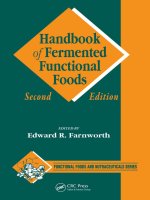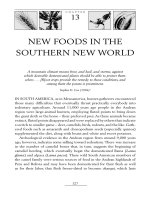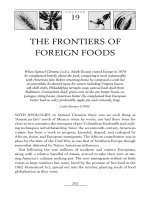Asian functional foods
Bạn đang xem bản rút gọn của tài liệu. Xem và tải ngay bản đầy đủ của tài liệu tại đây (10.45 MB, 671 trang )
sian
Functional
Foods
A
NUTRACEUTICAL SCIENCE AND TECHNOLOGY
Series Editor
FEREIDOON SHAHIDI, PH.D., FACS, FCIC, FCIFST, FRSC
University Research Professor
Department of Biochemistry
Memorial University of Newfoundland
St. John’s, Newfoundland, Canada
1. Phytosterols as Functional Food Components and Nutraceuticals,
edited by Paresh C. Dutta
2. Bioprocesses and Biotechnology for Functional Foods and Nu-
traceuticals, edited by Jean-Richard Neeser and Bruce J. German
3. Asian Functional Foods, John Shi, Chi-Tang Ho, and Fereidoon
Shahidi
ADDITIONAL VOLUMES IN PREPARATION
John Shi
Chi-Tang Ho
Fereidoon Shahidi
sian
Functional
Foods
A
This book contains information obtained from authentic and highly regarded sources. Reprinted
material is quoted with permission, and sources are indicated. A wide variety of references are
listed. Reasonable efforts have been made to publish reliable data and information, but the author
and the publisher cannot assume responsibility for the validity of all materials or for the conse-
quences of their use.
Neither this book nor any part may be reproduced or transmitted in any form or by any means,
electronic or mechanical, including photocopying, microfilming, and recording, or by any infor-
mation storage or retrieval system, without prior permission in writing from the publisher.
All rights reserved. Authorization to photocopy items for internal or personal use, or the personal
or internal use of specific clients, may be granted by CRC Press, provided that $1.50 per page
photocopied is paid directly to Copyright Clearance Center, 222 Rosewood Drive, Danvers, MA
01923 USA. The fee code for users of the Transactional Reporting Service is ISBN 0-8247-5855-
2/05/$0.00+$1.50. The fee is subject to change without notice. For organizations that have been
granted a photocopy license by the CCC, a separate system of payment has been arranged.
The consent of Marcel Dekker and CRC Press does not extend to copying for general distribution,
for promotion, for creating new works, or for resale. Specific permission must be obtained in
writing from Marcel Dekker/CRC Press for such copying.
Direct all inquiries to CRC Press, 2000 N.W. Corporate Blvd., Boca Raton, FL 33431.
Trademark Notice:
Product or corporate names may be trademarks or registered trademarks,
and are used only for identification and explanation, without intent to infringe.
Visit the CRC Press Web site at www.crcpress.com
© 2005 by Marcel Dekker/CRC Press
No claim to original U.S. Government works
International Standard Book Number 0-8247-5855-2
Library of Congress Card Number 2004057109
Printed in the United States of America 1 2 3 4 5 6 7 8 9 0
Printed on acid-free paper
Library of Congress Cataloging-in-Publication Data
Shi, John.
Asian functional foods / by John Shi, Chi-Tang Ho, and Fereidoon
Shahidi
p. cm.
Includes bibliographical references and index.
ISBN 0-8247-5855-2 (alk. paper)
1. Functional foods. 2. Diet—Asia. I. Ho, Chi-Tang, 1944- II.
Shahidi, Fereidoon, 1951- III. Title.
QP144.F85S535 2005
613.2'095 dc22 2004057109
DK3034_C000.fm Page iv Tuesday, January 4, 2005 2:54 PM
v
Preface
Health and “healing” foods have a long history in Asian cultures.
The Asians such as Chinese and Indians have long known that food
and medicine are from the same source and can treat illnesses and
build up a healthy life. The Chinese as well as other Asians are
proud of their heritage and the ingenuity of their early scientific and
cultural accomplishments. One of their most remarkable contributions
to civilization was the wealth of information they collected on the
uses of natural substances, plants, chemicals, and animals in treat-
ing illnesses. Many unique traditional Asian functional foods were
developed by combining food with herbal medicines. It appears that
both East and West are in agreement with these concepts. As early
as 2,500 years ago, Hippocrates, the father of the Western medicine,
said “Let your food be your medicine and medicine be your food.”
Traditional Asian functional foods derived from cereals, vegeta-
bles, and fruits are consumed on a regular basis and can be consid-
ered as nutritious supplements, while the special functional foods
such as herbs (ginseng,
Lingzhi
[Ganoderma]), meat (black-bone
chicken, duck skin) and some seafoods (sea cucumber) are consumed
less frequently. Many plants such as medicinal herbs have been
used for thousands of years to maintain health and treat disease.
They can be used either as a single herb or as multiple formulated
DK3034_C000.fm Page v Tuesday, January 4, 2005 2:54 PM
vi Shi, Ho, and Shahidi
herbs in herbal foods, teas, wines, congees, and pills (or powder).
Many of these herbal products have been shown to improve immu-
nopotentiation, increase systemic circulation, assist disease preven-
tion, and slow down the aging process.
The health benefits of muscle foods, including seafoods, have also
been known for thousands of years. The inhabitants of Asian coun-
tries, especially the Chinese, Japanese, and Indians, have for thou-
sands of years considered certain meat and meat products as special
health-healing foods. In addition, a number of nontraditional ani-
mal-derived foods, such as sea cucumber, shark cartilage and the
like are also found in Asian supermarkets and are considered as
health-enhancing food items.
Most Asian regions are located in tropical and subtropical and
monsoon zones. Thus many kinds of cereals, oil seeds, and nuts can
be cultivated. The traditional edible oils have been extracted from
seeds or nuts (groundnut, rapeseed, sesame, perilla, walnut, and
torreya) since ancient times. These oils have desirable flavor and
color as well as fat soluble antioxidative substances that possess
radical scavenging and antioxidant properties. Today more and more
people believe that Asian functional foods can prevent diseases,
maintain health, and make their dream of living longer and healthy
come true. The long history of Asian functional foods, where herbal
products are used as traditional medicines, and health care based
on natural products has given a new meaning to functional food in
the world. As traditional Asian functional foods gain the attention
of the general public, manufacturers will try to fill a growing con-
sumer appetite for these health-promoting products derived from
foods.
Traditionally, Asian functional foods were produced on a small
scale with manual operations, and then consumed locally. In the
last few decades, mass production of functional foods with modern
equipment and technologies has begun to play an increasingly
important role in the production of many Asian functional food
products. The production of functional foods, however, requires max-
imizing the retention of biologically active components that are
usually heat sensitive and susceptible to process-induced changes
as well as oxidative reactions.
During the past decade the consumption of functional foods has
emerged as a major consumer-driven trend, serving the needs of an
aging population that wants to exercise greater control over its
health and well being. This trend is expected to continue, and the
need for scientific information on all aspects of functional foods is
DK3034_C000.fm Page vi Tuesday, January 4, 2005 2:54 PM
Preface vii
vital to the advancement of this emerging sector. The increase in
consumer demand for functional food has prompted international
health organizations and governmental agencies to develop specific
guidelines for their production and use. Accordingly, the scientific
community must apply modern technologies to ensure the efficacy
and safety of these traditional functional foods before developing
them into first-class dietary supplements.
In order to gain a better understanding and to disseminate the
latest developments in this rapidly expanding field, this book,
Asian
Functional Foods
, in the Series of Nutraceutical Science and Tech-
nology, was developed. The 21 chapters in this book cover a wide
range of traditional Asian functional foods, including the source of
the traditional Asian functional foods, their history, functionality,
the chemical, physical and physiological properties, health benefits,
mechanisms of antioxidant action, anticancer, antiaging properties,
as well as clinical and epidemiological evidence. The processing
technology and process systems, equipment, material preparation,
food preparation, and quality control during processing are also
discussed. The stability, shelf life and storage technology (including
packaging technology) of traditional functional food products, indus-
trial production, homemade products, consumer and marketing
issues, and social and economical impact are also presented in these
chapters.
While Asian functional foods steadily gain in popularity in the
Western world, food cultures from the Western countries are also
being widely accepted in Asia. People around the world are accepting
the concept of functional foods as more than just a source of simple
nutrition. This book discusses the theoretical and practical aspects
of functional foods, from fundamental concepts of biochemistry,
nutrition, and physiology to food technology. The information in this
volume may initiate communications between East and West, and
open up areas of common interest. This in turn may generate oppor-
tunities for greater utilization of traditional Asian functional food
in the Western world.
The production of this book was made possible by the efforts of
international experts, and different areas are presented. This book
will be of interest to a wide spectrum of food scientists and technol-
ogists, nutritionists, biochemists, engineers, and entrepreneurs
worldwide. It will also serve to further stimulate the development
of functional foods and nutraceuticals, and contribute to providing
consumers worldwide with products that prevent diseases and
maintain health.
DK3034_C000.fm Page vii Tuesday, January 4, 2005 2:54 PM
DK3034_C000.fm Page viii Tuesday, January 4, 2005 2:54 PM
ix
About the Editors
John Shi
is a research scientist in Federal Department of Agricul-
ture and Agri-Food Canada, adjunct professor in University of
Guelph, Canada and South China Institute of Botany, Chinese Acad-
emy of Sciences, China. He is coeditor of
Functional Foods II.
He
graduated from Zhejiang University, China, and received an M.A.
degree in 1985, and Ph.D. degree in 1994 from the Polytechnic
University of Valencia, Spain. Dr Shi is an international editor of
Journal of Food Science and Nutrition
and
Nutraceuticals and
Foods
, a member of the editorial board of
Journal of Medicinal
Foods
, and
Journal of Agriculture, Food and Environment
. He is a
visiting professor and has done international collaborative research
at the Norwegian Institute of Fishery and Aquaculture, and Lleida
University, Spain. His current research interests focus on separation
technologies for health-promoting components from natural prod-
ucts to develop functional foods.
Professor Chi-Tang Ho
received his B.S. degree in chemistry from
National Taiwan University in Taipei, Taiwan in 1968. He then went
on to receive both his M.A. in 1971 and his Ph.D. in 1974 in organic
chemistry from Washington University in St. Louis. After complet-
ing two years as a postdoctorate fellow at Rutgers University, he
DK3034_C000.fm Page ix Tuesday, January 4, 2005 2:54 PM
x Shi, Ho, and Shahidi
joined the Rutgers faculty as an assistant professor in the Depart-
ment of Food Science. He was promoted to associate professor in
1983. In 1987 he was promoted to Professor I, and in 1993 he was
promoted to Professor II. He has published over 480 papers and
scientific articles, edited 27 professional books and is an editorial
board member for a variety of publications, including the Journal
of Agricultural and Food Chemistry. He has also won numerous
awards including the Stephen S. Chang Award in Lipid and Flavor
Science from the Institute of Food Technology and two honorary
professorships, and has served in the Division of Agricultural and
Food Chemistry of the American Chemical Society in various posi-
tions including as division chair. His current research interests focus
on flavor chemistry and the antioxidant and anti-cancer properties
of natural products.
Fereidoon Shahidi
, Ph.D., FACS, FCIC, FCIFST, FRSC, has
reached the highest academic level, university research professor,
in the Department of Biochemistry at Memorial University of New-
foundland (MUN). He is also cross-appointed to the Department of
Biology, Ocean Sciences Centre, and the aquaculture program at
MUN. Dr. Shahidi is the author of nearly 500 research papers and
book chapters and has authored or edited over 30 books and made
over 300 presentations at scientific conferences. His research con-
tributions have led to several industrial developments around the
globe.
Dr. Shahidi's current research interests include different areas
of nutraceuticals and functional foods as well as marine foods and
natural antioxidants, among others. Dr. Shahidi serves as the editor-
in-chief of the
Journal of Food Lipids
and is an editorial board
member of
Food Chemistry
,
Journal of Food Science
,
Journal of
Agricultural and Food Chemistry
,
Nutraceuticals and Food
, and the
International Journal of Food Properties
. He was the recipient of
the 1996 William J. Eva Award from the Canadian Institute of Food
Science and Technology in recognition of his outstanding contribu-
tions to food science in Canada through research and service, and
also the 1998 Earl P. McFee Award from the Atlantic Fisheries
Technological Society in recognition of his exemplary contributions
in the seafood area and their global impact. He has also been
recognized as one of the most highly cited authors in the world in
the discipline of agriculture, plant and animal sciences and was the
recipient of the 2002 ADM Award from the American Oil Chemists'
Society.
DK3034_C000.fm Page x Tuesday, January 4, 2005 2:54 PM
About the Editors xi
Dr. Shahidi is the immediate past chairperson of the nutraceu-
ticals and functional foods division of the Institute of Food Technol-
ogists and the past chair of Lipid Oxidation and Quality of the
American Oil Chemists' Society. He is also the chair of the agricul-
tural and food chemistry division of the American Chemical Society.
Dr. Shahidi serves as a member of the Expert Advisory Panel of
Health Canada on Standards of Evidence for Health Claims for
Foods, Standards Council of Canada on Fats and Oils, Advisory
Group of Agriculture and Agri-Food Canada on Plant Products and
the Nutraceutical Network of Canada. He is a member of the Wash-
ington-based Council of Agricultural Science and Technology on
Nutraceuticals.
DK3034_C000.fm Page xi Tuesday, January 4, 2005 2:54 PM
DK3034_C000.fm Page xii Tuesday, January 4, 2005 2:54 PM
xiii
Series Introduction
The Nutraceutical Science and Technology series provides a com-
prehensive and authoritative source of the most recent information
for those interested in the field of nutraceuticals and functional
foods. There is a growing body of knowledge, sometimes arising from
epidemiological studies and often substantiated by preclinical and
clinical studies, demonstrating the relationship between diet and
health status. Many of the bioactives present in foods, from both
plant and animal sources, have been shown to be effective in disease
prevention and health promotion. The emerging findings in the
nutrigenomics and proteomics areas further reflect the importance
of diet in a deeper sense, and this, together with the increasing
burden of prescription drugs in treatment of chronic diseases such
as cardiovascular ailments, certain types of cancer, diabetes, and a
variety of inflammatory diseases, has raised interest in functional
foods and nutraceuticals to a new high. The interest is quite wide-
spread from producers to consumers, regulatory agencies, and
health professionals.
In this series, particular attention is paid to the most recent and
emerging information on a range of topics covering the chemistry,
DK3034_C000.fm Page xiii Tuesday, January 4, 2005 2:54 PM
xiv Shi, Ho, and Shahidi
biochemistry, epidemiology, nutrigenomics and proteomics, engi-
neering, formulation, and processing technologies related to nutra-
ceuticals, functional foods, and dietary supplements. Quality man-
agement, safety, and toxicology, as well as disease prevention and
health promotion aspects of products of interest, are addressed. The
series also covers relevant aspects of preclinical and clinical trials,
as well as regulatory and labeling issues.
This series provides much needed information on a variety of
topics. It addresses the needs of professionals, students, and prac-
titioners in the fields of food science, nutrition, pharmacy, and
health, as well as leads conscious consumers to the scientific origin
of health-promoting substances in foods, nutraceuticals, and dietary
supplements. Each volume covers a specific topic of related foods or
prevention of certain types of diseases, including the process of
aging.
Fereidoon Shahidi
DK3034_C000.fm Page xiv Tuesday, January 4, 2005 2:54 PM
xv
Contributors
Suad N. Al-Hooti
Biotechnology Department, Kuwait Institute
for Scientific Research, Safat, Kuwait
Toyohiko Ariga
Laboratory of Nutrition and Physiology, Depart-
ment of Biological and Agricultural Chemistry, Nihon University
College of Bioresource Sciences, Fujisawa, Japan
Karen J. Auborn
North Shore—Long Island Jewish Research
Institute, Manhasset, New York, Departments of Otolaryngology
and Microbiology and Immunology, Albert Einstein College of Med-
icine, Bronx, New York, U.S.A.
C. J. Carriere
Cereal Products and Food Science Research Unit,
National Center for Agricultural Utilization Research, ARS, USDA,
Peoria, Illinois, U.S.A.
Chung Chi Chou
New Orleans, Louisiana, U.S.A.
Yi Dang
Beijing University of Chinese Medicine, Beijing, China
Hao Feng
Department of Food Science and Human Nutrition,
University of Illinois at Urbana-Champaign, Urbana, Illinois, U.S.A.
DK3034_C000.fm Page xv Tuesday, January 4, 2005 2:54 PM
xvi Shi, Ho, and Shahidi
Yasuko Fukuda
Nagoya Women’s University, Nagoya, Japan
Asbjørn Gildberg
Norwegian Institute of Fisheries and Aquac-
ulture Research, Tromsø, Norway
Chi-Tang Ho
Department of Food Science, Rutgers University,
New Brunswick, New Jersey, U.S.A.
G.E. Inglett
Cereal Products and Food Science Research Unit,
National Center for Agricultural Utilization Research, ARS, USDA,
Peoria, Illinois, U.S.A.
Hideji Itokawa
Natural Products Laboratory, School of Pharmacy,
University of North Carolina, Chapel Hill, North Carolina, U.S.A.
Yi Jin
Department of Food Science, Rutgers University, New
Brunswick, New Jersey, U.S.A.
Keun-Ok Jung
Pusan National University, Busan, Korea
Kenji Koge
Planning and Research Section, Chigasaki Labora-
tory, Shin Mitsui Sugar Co., Ltd., Kanagawa-ken, Japan
Mutsuo Kozuka
Natural Products Laboratory, School of Phar-
macy, University of North Carolina, Chapel Hill, North Carolina,
U.S.A.
Tai-Wan Kwon
Department of Food and Nutrition, Inje Univer-
sity, Kimhae, Korea
Cherl-Ho Lee
Graduate School of Biotechnology, Korea Univer-
sity, Seoul, Korea
Kuo-Hsiung Lee
Natural Products Laboratory, School of Phar-
macy, University of North Carolina, Chapel Hill, North Carolina,
U.S.A.
Su-Rae Lee
Division of Agricultural and Fishery Sciences,
Korean Academy of Science and Technology, Gyeonggi-Do, Korea
S. Maneepun
Institute of Food Research and Product Develop-
ment, Kasetsart University, Bangkok, Thailand
DK3034_C000.fm Page xvi Tuesday, January 4, 2005 2:54 PM
Contributors xvii
Teruo Miyazawa
Food and Biodynamic Chemistry Laboratory,
Graduate School of Agriculture Science, Tohoku University, Sendai,
Japan
Scott A. Morris
Department of Food Science and Human Nutri-
tion, University of Illinois at Urbana-Champaign, Urbana, Illinois,
U.S.A.
James H. Moy
Department of Molecular Biosciences and Biosys-
tems Engineering, University of Hawaii at Manoa, Honolulu, Hawaii,
U.S.A.
W.J. Mullin
Agriculture and Agri-Food Canada, Ontario, Canada
Mayumi Nagashima
Department of Culture and Domestic Sci-
ence, Nagoya Keizai University Junior College, Aichi, Japan
Kiyotaka Nakagawa
Food and Biodynamic Chemistry Lab-
oratory, Graduate School of Agriculture Science, Tohoku University,
Sendai, Japan
Kun-Young Park
Pusan National University, Busan, Korea
Sook-Hee Rhee
Pusan National University, Busan, Korea
Michael Saska
Audubon Sugar Institute, Louisiana State Uni-
versity Agricultural Center, Baton Rouge, Louisiana, U.S.A.
Taiichiro Seki
Laboratory of Nutrition and Physiology, Depart-
ment of Biological and Agricultural Chemistry, Nihon University
College of Bioresource Sciences, Fujisawa, Japan
Fereidoon Shahidi
Department of Biochemistry, Memorial Uni-
versity of Newfoundland, St. John’s, Newfoundland, Canada
John Shi
Guelph Food Research Center, Agriculture and Agri-
Food Canada, Guelph, Ontario, Canada
Jiwan S. Sidhu
Department of Family Sciences, College for
Women, Kuwait University Safat, Kuwait
DK3034_C000.fm Page xvii Tuesday, January 4, 2005 2:54 PM
xviii Shi, Ho, and Shahidi
James E. Simon
New Use Agriculture and Natural Plant Prod-
ucts Program, Department of Plant Biology and Pathology, Rutgers
University, New Brunswick, New Jersey, U.S.A.
Chaufah Thongthai
Mahidol University, Bangkok, Thailand
Mark L. Wahlqvist
Monash Asia Institute, Monash University,
Melbourne, Australia
Mingfu Wang
New Use Agriculture and Natural Plant Products
Program, Department of Plant Biology and Pathology, Rutgers Uni-
versity, New Brunswick, New Jersey, U.S.A.
Naiyana Wattanapenpaiboon
Monash Asia Institute, Monash
University, Melbourne, Australia
Qing-Li Wu
New Use Agriculture and Natural Plant Products
Program, Department of Plant Biology and Pathology, Rutgers Uni-
versity, New Brunswick, New Jersey, U.S.A.
Youling L. Xiong
Department of Animal Sciences, University of
Kentucky, Lexington, Kentucky, U.S.A.
DK3034_C000.fm Page xviii Tuesday, January 4, 2005 2:54 PM
xix
Table of Contents
1. Functional Foods and Their Impact on Nutrition and
Health: Opportunities in the Asia Pacific 1
Mark L. Wahlqvist and Naiyana Wattanapenpaiboon
2. Asian Herbal Products: The Basis for Development of
High-Quality Dietary Supplements and New Medicines 21
Kuo-Hsiung Lee, Hideji Itokawa, and Mutsuo Kozuka
3. Chemistry, Pharmacology, and Quality Control of
Selected Popular Asian Herbs in the U.S. Market 73
Mingfu Wang, Qing-Li Wu, James E. Simon, Yi Jin,
and Chi-Tang Ho
4. Health-Related Fat Replacers Prepared from Grain for
Improving Functional and Nutritive Values of Asian
Foods 103
George E. Inglett, Craig J. Carriere, and Saipin Maneepun
DK3034_C000.fm Page xix Tuesday, January 4, 2005 2:54 PM
5. Antiaging Properties of Asian Functional Foods: A
Historical Topic Closely Linked to Longevity 129
Yi Dang
6. A New Treatment and Prevention Strategy for Human
Papillomaviruses 145
Karen J. Auborn
7. Traditional Functional Foods in Korea 159
Su-Rae Lee
8. Evolution of Korean Dietary Culture and Health Food
Concepts 187
Cherl-Ho Lee and Tai-Wan Kwon
9. Asian Fish Sauce as a Source of Nutrition 215
Chaufah Thongthai and Asbjørn Gildberg
10. Nutraceuticals from Seafood and Seafood By-Products 267
Fereidoon Shahidi
11. Functional Foods from Meat Animals 289
Youling L. Xiong
12. Functional Foods from Fruit and Fruit Products 303
John Shi and James H. Moy
13. Functional Foods from Fermented Vegetable Products:
Kimchi (Korean Fermented Vegetables) and
Functionality 341
Kun-Young Park and Sook-Hee Rhee
14. Antioxidative Function of Seeds and Nuts and Their
Traditional Oils in the Orient 381
Yasuko Fukuda and Mayumi Nagashima
DK3034_C000.fm Page xx Tuesday, January 4, 2005 2:54 PM
Table of Contents xxi
15. Antioxidants and Other Functional Extracts from
Sugarcane 411
Kenji Koge, Michael Saska, and Chung Chi Chou
16. Functional Foods from Garlic and Onion 433
Toyohiko Ariga and Taiichiro Seki
17. Functional Foods from Date Fruits 491
Jiwan S. Sidhu and Suad N. Al-Hooti
18. Functional Foods and Products from Japanese
Green Tea 525
Teruo Miyazawa and Kiyotaka Nakagawa
19. Miso as a Functional Food 537
W. J. Mullin
20. Fermented Soybean Products as Functional Foods:
Functional Properties of Doenjang (Fermented
Soybean Paste) 555
Kun-Young Park and Keun-Ok Jung
21. Conventional and Emerging Food Processing Technologies
for Asian Functional Food Production 597
Hao Feng and Scott A. Morris
Index
635
DK3034_C000.fm Page xxi Tuesday, January 4, 2005 2:54 PM
xxii Shi, Ho, and Shahidi
DK3034_C000.fm Page xxii Tuesday, January 4, 2005 2:54 PM
1
1
Functional Foods and Their Impact
on Nutrition and Health:
Opportunities in the Asia Pacific
MARK L. WAHLQVIST and
NAIYANA WATTANAPENPAIBOON
PEOPLE IN ASIA
Countries of the Asian Pacific region have a wide range of
nutritional status, with some countries wrestling with prob-
lems of undernutrition (like Cambodia, Myanmar, and Papua
New Guinea), and others suffering more from health problems
associated with overnutrition (such as Australia and Sin-
gapore). In between are countries (such as China and Malaysia),
where the transition from a closed economy to an open econ-
omy takes place, the so-called “diseases of affluence” (obesity,
diabetes, cardiovascular disease, osteoporosis, and certain
cancers) may coexist with those of “undernutrition” (protein-
energy malnutrition, micronutrient deficiency, and food-borne
illness). This phenomenon of the double burden of disease is
now increasingly common.
1
This requires the application of a
DK3034_book.fmPage1Monday,December20,20049:26AM
2Wahlqvist and Wattanapenpaiboon
new paradigm, arguably one that more effectively relates the
human condition to the environment.
2
There is great potential
to address both sets of problems through nutritional means.
KEY PUBLIC HEALTH NUTRITION ISSUES
IN THE ASIA PACIFIC REGION
Transitional Health
The emerging nutrition problems in the Asia Pacific region
are probably partly explained by the Barker hypothesis, also
referred to as the thrifty phenotype hypothesis.
3,4
It is postu-
lated that nutritional transition begins
in utero
where the
mother is exposed to nutritional inadequacy. In response to
maternal and fetal malnutrition, there are adaptive changes,
in order to survive, in fetal organ development. These adapta-
tions may permanently alter adult physiology and metabolism
in ways that are beneficial to survival under continued con-
ditions of malnutrition, but detrimental when the food supply
is abundant. This fetal “programming” is thought to lead to
increased rates of coronary heart disease, hypertension, insulin
resistance syndrome, noninsulin-dependent diabetes, obesity,
osteoporosis, and some cancers later in life.
Urbanization and its Effects
This social change has a remarkable effect on diet in the
developing countries. Urbanization increases labor-force par-
ticipation of women and it indirectly affects the diet of the
family.
5
Whereas the food supply of rural populations comes
from its own food production, the food supply of urban popu-
lations has to be purchased, and more processed, rather than
represent fresh animal products and garden produce.
6
Changing Demography with an Aging Population
There are increasing numbers of people in communities that
age to 70, 80, and beyond. Thus, it is increasingly important
to understand the relationship between food and health in
later life.
DK3034_book.fmPage2Monday,December20,20049:26AM









